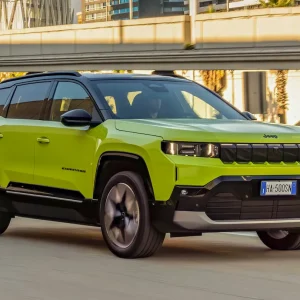Nissan’s new NP300 Navara arrives in UK showrooms in January 2016 carrying added interest and significance: the 12th generation of the manufacturer’s pick-up will form the basis for the subsequent models coming from Renault and Mercedes.
The Navara (the NP tag means ‘Nissan pick-up’) is also the second truck to break cover in a raft of new contenders coming over the next 18 months, after July’s arrival of the Mitsubishi L200.
The pick-up now uses the 2.3-litre diesel engine that powers the NV400 van. It replaces the 2.5-litre unit from the previous model and is available with 160hp and 190hp, the latter Nissan’s first twin-turbo engine in an LCV. Just as significantly, double-cab versions get the sophisticated new multi-link (five-link) with coil-spring rear suspension. King cabs and chassis cabs once more come with rigid leaf-spring rear suspension.
The new Navara is up for grabs in five trim levels: Visia, Acenta, Acenta+, N-Connecta and Tekna. Prices (all excluding VAT) start from £18,376 for the king-cab 2WD Visia.
The bottom two trim levels are offered in either king or double-cab formats whereas the top three specifications come just as double-cabs. The entry-level Visia is the only derivative available in 2WD.
The Visia 4WD king cab costs £19,209, with an £833 step to double-cab.
Standard safety features across the range include forward emergency braking on double-cabs; seven airbags on all models; and an electronic limited slip differential, hill-start assist and hill-descent control on 4WD models.
Nissan has endowed the new Navara with generous specification from the entry level upwards, and the Visia gets manual aircon in 4WD format as well as Bluetooth telephone integration, steering wheel-mounted audio controls, aux socket, USB port, three 12V sockets, auto lights and cruise control.
The Navara holds up well as a workhorse, despite maximum payload limits dropping versus the previous model. All payload capacities remain above the critical 1.0t mark that releases the trucks from VAT liability. The best, the Visia king cab 2WD, can hump 1136kg.
In terms of towing, the Navara’s 3.5t limit remains the joint beefiest alongside the Ford Ranger and Isuzu D-max.
But it is fuel economy where Nissan has dramatically improved, making Mitsubishi’s claim to be the greenest pick-up of the bunch short-lived.
Whereas the previous-generation truck achieved just 33.6mpg on the combined cycle, the new Navara manages 44.1mpg for the most frugal Visia king cab, Nissan claims, compared with the L200’s 42.8mpg.
What’s more, the Navara now boasts a fresh-air-friendlier 167g/km of CO2 against the Mitsubishi’s 169g/km.
The new model has a bold, muscular stance, with the V-shaped grille and curvaceous flanks echoing the styling of the brand’s passenger crossover models such as the X-trail and Qashqai.
We tested the double-cab Navara in the flagship Tekna trim level (expected to be the top seller) with the new seven-speed auto that Nissan has brought over from its Infiniti prestige car line-up. This derivative gets the new five-link rear suspension.
Even without a load in the cargo bay the ride is strikingly smooth and consistent without any of the bounciness one would normally expect when driving an unladen pick-up. For this we have to thank the new multi-link suspension system and it is hard to dispute Nissan’s claim that the Navara drives like one of its crossover vehicles.
On-road, the driving experience is enhanced by the auto ‘box that goes about its business smoothly and with minimum fuss, although it can be a little out of its comfort zone when accelerating hard and is not quite as slick as the VW Amarok’s eight-speed auto.
The steering delivers a sense of stability at higher speeds and when cornering, although we did find it a little light and lacking in feedback. On the other hand, this lightness does take the strain out of parking. The steering column adjusts for rake but not reach, unlike that of the new L200, which goes both ways.
Nissan has reduced the Navara’s wheelbase by 50mm, which improves manoeuvrability by enabling a turning circle of 12.4m, although this still exceeds the L200’s 11.8m.
Off-road, a central dial selects ‘4LO’ mode to tackle conditions such as steep and slippery inclines. Hill-descent control can be activated by pressing a button on the central console to help descents, while hill-start assist stops the vehicle rolling backwards.
Nissan Navara NP300 Tekna 2.3 190hp |
| Model price range (excl. VAT) £18,376-£25,710 |
| Insurance group 12E |
| Warranty 5yrs/100,000mls |
| Service intervals 2yrs/18,000mls |
| Load bay length 1578mm |
| Min/max load bay width 1130mm/1560mm |
| Gross payload 1052kg |
| Engine size/power 2298cc/190hp |
| Fuel consumption 40.3mpg |
| CO2 183g/km |





